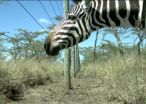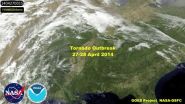(Press-News.org) Scientists at Dana-Farber Cancer Institute have identified natural human antibodies against the virus that causes Middle East Respiratory Syndrome (MERS), a step toward developing treatments for the newly emerging and often-fatal disease.
Currently there is no vaccine or antiviral treatment for MERS, a severe respiratory disease with a mortality rate of more than 40 percent that was first reported in Saudi Arabia in 2012.
In laboratory studies reported in the Proceedings of the National Academy of Sciences (PNAS), the researchers found that these "neutralizing" antibodies prevented a key part of the virus, known as MERS CoV, from attaching to protein receptors that allow the virus to infect human cells. The research was led by Wayne Marasco, MD, an infectious disease expert at Dana-Farber.
Further experiments are underway that could lead to development of antibody preventives and treatments for MERS, according to the scientists. Investigators from the University of North Carolina at Chapel Hill are co-authors of the report.
"This panel of neutralizing antibodies offers the possibility of developing human monoclonal antibody-based immunotherapy, especially for health care workers," noted the authors.
Symptoms of MERS infection include cough, fever and shortness of breath, and can lead to pneumonia and kidney failure. The World Health Organization has recorded more than 250 cases and at least 93 deaths, mainly in countries of the Arabian Peninsula. A number of cases and deaths have been in health care workers and hospital patients.
On April 21 Saudi Arabia's King Abdullah fired the country's health minister amid a surge in new MERS infections – 49 in a single week. Reports of MERS in Greece, England, France, Italy, Malaysia and other countries have raised concerns about potential global spread of the disease by infected airline passengers. The MERS virus has been found in camels and bats but scientists don't yet know precisely how it is transmitted to people.
The virus is similar to the Severe Acute Respiratory Syndrome virus, SARS CoV, that caused hundreds of deaths in China in 2002 and 2003. SARS was less lethal, having a death rate of about 10 percent.
Marasco and colleagues found the MERS antibodies using a "library" of some 27 billion human antibodies they have created and maintain in a freezer at Dana-Farber; it is one of the largest such libraries in the world. Antibodies are proteins made by the immune system that recognize foreign viruses and bacteria. A neutralizing antibody is one that not only recognizes a specific virus but also prevents it from infecting host cells, so eventually the infection is "cleared" from the individual. The research team plucked seven MERS-specific neutralizing antibodies from the library after using samples of the virus to screen for them.
MERS CoV (CoV stands for coronavirus) has on its surface an array of spike-shaped proteins that bind to host cells – specifically to receptor proteins called DPP4 on the surface of cells that line human airways. The neutralizing antibodies identified in the study prevented the virus' spikes from binding to the DPP4 receptors.
The researchers selected one of the antibodies, labeled 3B11, as a "lead" candidate for further research. Marasco said the antibody has been produced in sufficient quantities to begin testing in non-human primates and mice to determine if they protect against the virus. However these studies have been delayed because no good animal model for MERS has been developed, added Marasco.
Although the disease hasn't been seen in North America, "the chance of someone infected with MERS landing on US shores is possible since international travelers that have been to the Arabian peninsula and exposed to the MERS CoV may be asymptomatic at the time of their travel" said Marasco, whose research on the virus is funded in part by the Defense Advanced Research Projects Agency (DARPA) and the National Institutes of Health. He said he was contacted by DARPA soon after MERS was first reported in 2012 and asked to study the virus from the viewpoint of biological defenses against it.
The report in PNAS said laboratory studies of how the virus evolves in response to exposure to neutralizing antibodies suggest that the MERS virus won't easily shape- shift to evade antibody treatments, as some viruses do. Marasco's team found that the same mutations that enabled the MERS virus to escape neutralizing antibodies also weakened the virus' ability to replicate.
Marasco added that an antibody-based treatment for MERS would be administered by injection and could provide protection for about three weeks.
INFORMATION:
First authors of the publication are Xian-Chun Tang, PhD, of Dana-Farber and Sudhakar Agnihothram of University of North Carolina at Chapel Hill.
The research was supported by DARPA grant W911NF-10-0226 and National Institutes of Health grant R01AI085524.
About Dana-Farber Cancer Institute
Dana-Farber Cancer Institute, a principal teaching affiliate of Harvard Medical School, is world-renowned for its leadership in adult and pediatric cancer treatment and research. Designated as a comprehensive cancer center by the National Cancer Institute (NCI), it is one of the largest recipients among independent hospitals of NCI and National Institutes of Health grant funding. For more information, go to http://www.dana-farber.org.
Scientists identify antibodies against deadly emerging disease
Human antibodies could lead to prevention and treatment of Middle East respiratory syndrome
2014-04-28
ELSE PRESS RELEASES FROM THIS DATE:
Study: Tart cherry juice increases sleep time in adults with insomnia
2014-04-28
SAN DIEGO, Calif. April 28, 2014 – A morning and evening ritual of tart cherry juice may help you sleep better at night, suggests a new study presented today at the Experimental Biology 2014 meeting. Researchers from Louisiana State University found that drinking Montmorency tart cherry juice twice a day for two weeks helped increase sleep time by nearly 90 minutes among older adults with insomnia.
These findings were presented Monday, April 28, at the "Dietary Bioactive Components: Antioxidant and Anti-inflammatory Effects of Dietary Bioactive Components" section of ...
Decrease in large wildlife drives an increase in rodent-borne disease and risk to humans
2014-04-28
Populations of large wildlife are declining around the world, while zoonotic diseases (those transmitted from animals to humans) are on the rise. A team of Smithsonian scientists and colleagues have discovered a possible link between the two. They found that in East Africa, the loss of large wildlife directly correlated with a significant increase in rodents, which often carry disease-causing bacteria dangerous to humans. The team's research is published in the Proceedings of the National Academy of Sciences, April 28.
"Our study shows us that ecosystem health, wildlife ...
Smart home programming: Easy as 'if this, then that'
2014-04-28
PROVIDENCE, R.I. [Brown University] — The idea of a smart home sounds promising enough. Who doesn't want a house full of automated gadgets — from light switches to appliances to heating systems — that know exactly when to turn on, turn off, heat up or power down?
But in order for all those devices to do what they're supposed to do, they'll need to be programed — a task the average homeowner might not have the interest or the tech-savvy to perform. And nobody wants to call tech support just to turn on a light.
A group of computer science researchers from Brown and Carnegie ...
Satellite movie shows US tornado outbreak from space
2014-04-28
VIDEO:
This animation of NOAA's GOES-East satellite data shows the development and movement of the weather system that spawned tornadoes affecting seven central and southern US states on Apr. 27-28, 2014....
Click here for more information.
NASA has just released an animation of visible and infrared satellite data from NOAA's GOES-East satellite that shows the development and movement of the weather system that spawned tornadoes affecting seven central and southern U.S. states ...
NIH scientists establish monkey model of hantavirus disease
2014-04-28
WHAT: National Institutes of Health (NIH) researchers have developed an animal model of human hantavirus pulmonary syndrome (HPS) in rhesus macaques, an advance that may lead to treatments, vaccines and improved methods of diagnosing the disease. The study, conducted by researchers at NIH’s National Institute of Allergy and Infectious Diseases (NIAID), is published in the Proceedings of the National Academy of Sciences.
People become infected with hantaviruses by inhaling virus from the urine, droppings or saliva of infected rodents. This infection can progress to HPS, ...
A water test for the world
2014-04-28
HAMILTON, April 28, 2014 – Inspiration can come in many forms, but this one truly was a breath of fresh air.
A group of McMaster researchers has solved the problem of cumbersome, expensive and painfully slow water-testing by turning the process upside-down.
Instead of shipping water to the lab, they have created a way to take the lab to the water, putting potentially life-saving technology into the hands of everyday people.
The team has reduced the sophisticated chemistry required for testing water safety to a simple pill, by adapting technology found in a dissolving ...
Technological advancements extend survival of transplanted hearts across species
2014-04-28
The use of transplant organs from animals (xenotransplantation) could help to compensate for the shortage of human organs available for transplant. NIH researchers have demonstrated that by using hearts from genetically engineered pigs in combination with target-specific immunosuppression of recipient baboons, organ survival can be significantly prolonged. This has potential for paving the way for the use of animal organs for transplantation into humans.
Toronto, ON, Canada, April 28, 2014 – Cardiac transplantation is the treatment of choice for end stage heart failure. ...
Disney Researchers use 3-D printing to produce interactive speakers of any shape
2014-04-28
Forget everything you know about what a loudspeaker should look like. Scientists at Disney Research, Pittsburgh have developed methods using a 3D printer to produce electrostatic loudspeakers that can take the shape of anything, from a rubber ducky to an abstract spiral.
The simple speakers require little assembly, but even those few manual steps might be eliminated in the future, said Yoshio Ishiguro, a Disney Research, Pittsburgh post-doctoral associate. "In five to 10 years, a 3D printer capable of using conductive materials could create the entire piece," he predicted.
The ...
Well-informed patients key to accepting gene-based drug dosing
2014-04-28
A new study out of Western University (London, Canada) illustrates the need for a lot more education around pharmacogenetics (PGx) –the study of how a patient's genes can affect drug reaction and dosage. PGx promises to optimize patient response to therapy, but this is the first study to really investigate how patients perceive this kind of genetic testing, and whether those perceptions differ when it comes to parents and their children. The research, led by Dr. Michael Rieder of Western's Schulich School of Medicine & Dentistry is published in the journal Pediatrics.
"Pharmacogenetic ...
The thin-crusted US Sierra Nevada Mountains: Where did the Earth go?
2014-04-28
Boulder, Colo., USA – In an addition to Geosphere's ongoing themed issue series, "Geodynamics and Consequences of Lithospheric Removal in the Sierra Nevada, California," Craig H. Jones of the University of Colorado Boulder and colleagues examine the seismological study of the entire extent of the U.S. Sierra Nevada range using seismograms collected in the Sierra Nevada EarthScope field experiment from 2005 to 2007.
The southern Sierra Nevada is known to have unusually thin crust for mountains with such high elevations (peaks higher than 4 km/14,000 ft, and average elevations ...
LAST 30 PRESS RELEASES:
Tracing the quick synthesis of an industrially important catalyst
New software sheds light on cancer’s hidden genetic networks
UT Health San Antonio awarded $3 million in CPRIT grants to bolster cancer research and prevention efforts in South Texas
Third symposium spotlights global challenge of new contaminants in China’s fight against pollution
From straw to soil harmony: International team reveals how biochar supercharges carbon-smart farming
Myeloma: How AI is redrawing the map of cancer care
Manhattan E. Charurat, Ph.D., MHS invested as the Homer and Martha Gudelsky Distinguished Professor in Medicine at the University of Maryland School of Medicine
Insilico Medicine’s Pharma.AI Q4 Winter Launch Recap: Revolutionizing drug discovery with cutting-edge AI innovations, accelerating the path to pharmaceutical superintelligence
Nanoplastics have diet-dependent impacts on digestive system health
Brain neuron death occurs throughout life and increases with age, a natural human protein drug may halt neuron death in Alzheimer’s disease
SPIE and CLP announce the recipients of the 2025 Advanced Photonics Young Innovator Award
Lessons from the Caldor Fire’s Christmas Valley ‘Miracle’
Ant societies rose by trading individual protection for collective power
Research reveals how ancient viral DNA shapes early embryonic development
A molecular gatekeeper that controls protein synthesis
New ‘cloaking device’ concept to shield sensitive tech from magnetic fields
Researchers show impact of mountain building and climate change on alpine biodiversity
Study models the transition from Neanderthals to modern humans in Europe
University of Phoenix College of Doctoral Studies releases white paper on AI-driven skilling to reduce burnout and restore worker autonomy
AIs fail at the game of visual “telephone”
The levers for a sustainable food system
Potential changes in US homelessness by ending federal support for housing first programs
Vulnerability of large language models to prompt injection when providing medical advice
Researchers develop new system for high-energy-density, long-life, multi-electron transfer bromine-based flow batteries
Ending federal support for housing first programs could increase U.S. homelessness by 5% in one year, new JAMA study finds
New research uncovers molecular ‘safety switch’ shielding cancers from immune attack
Bacteria resisting viral infection can still sink carbon to ocean floor
Younger biological age may increase depression risk in older women during COVID-19
Bharat Innovates 2026 National Basecamp Showcases India’s Most Promising Deep-Tech Ventures
Here’s what determines whether your income level rises or falls
[Press-News.org] Scientists identify antibodies against deadly emerging diseaseHuman antibodies could lead to prevention and treatment of Middle East respiratory syndrome






